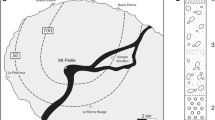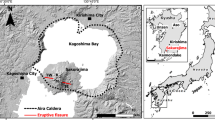Abstract
Batur volcanic field (BVF) in Bali, Indonesia, underwent two successive caldera-forming eruptions, CI and CII (29,300 and 20,150 years b.p., respectively) that resulted in the deposition of dacitic ignimbrites. The respective ignimbrites show contrasted stratigraphies, exemplify the variability of dynamics associated with caldera-forming eruptions and provide insights into the possible controls exerted by caldera collapse mechanisms. The Ubud Ignimbrite is widespread and covers most of southern Bali. The deposits consist dominantly of pyroclastic flow with minor pumice fall deposits. The intra-caldera succession comprises three distinct, partially to densely welded cooling units separated by non-welded pyroclastic flow and fall deposits. The three cooling units consist of pyroclastic flow deposits only and together represent up to 16 distinct flow units, each including a thin, basal, lithic-rich breccia. This eruption was related to a 13.5×10 km caldera (CI) with a minimum collapsed volume of 62 km3. The floor of caldera CI is inferred to have a piecemeal geometry. The Ubud Ignimbrite is interpreted as the product of a relatively long-lasting, pulsating, collapsing fountain that underwent at least two time breaks. A stable column developed during the second time break. Discharge rate was high overall, but oscillatory, and increased toward the end of the eruption. These dynamics are thought to reflect sequential collapse of the CI structure. The Gunungkawi Ignimbrite is of more limited extent outside the source caldera and occurs only in central southern Bali. The Gunungkawi Ignimbrite proximal deposits consist of interbedded accretionary lapilli-bearing ash surge, ash fall, pumice lapilli fall and thin pyroclastic flow deposits, overlain by a thick and massive pyroclastic flow deposit with a thick basal lag breccia. The caldera (CII) is 7.5×6 km in size, with a minimum collapsed volume of 9 km3. The CII eruption included two distinct phases. During the first, eruption intensity was low to moderate and an unstable, essentially phreatomagmatic column developed. During the second phase, the onset of caldera collapse drastically increased the eruption intensity, resulting in column collapse. The caldera floor is believed to have subsided rapidly, producing a single, short-lived burst of high eruption intensity that resulted in the deposition of the uppermost massive pyroclastic flow.













Similar content being viewed by others
References
Acocella V, Cifelli F, Funiciello R (2000) Analogue models of collapse calderas and resurgent domes. J Volcanol Geotherm Res104:81–96
Allen SR (2001) Reconstruction of a major caldera-forming eruption from pyroclastic deposit characteristics: Kos Plateau Tuff, eastern Aegean Sea. J Volcanol Geotherm Res 105:141–162
Aramaki S (1984) Formation of the Aira Caldera, Southern Kyushu, ~22,000 years ago. J Geophys Res 89(B10):8485–8501
Bacon RC (1983) Eruptive history of Mount Mazama and Crater Lake caldera, Cascade Range, USA. J Volcanol Geotherm Res 18:57–115
Carey S, Sigurdsson H (1989) The intensity of plinian eruptions. Bull Volcanol 51:28–40
Curray JR, Shor GG, Raitt RW, Henry M (1977) Seismic refraction and reflection studies of crustal structure of the eastern Sunda and western Banda arcs. J Geophys Res 82:2479–2489
Druitt TH (1985) Vent evolution and lag breccia formation during the Cape Riva eruption of Santorini, Greece. J Geol 93:439–454
Druitt TH, Mellors RA, Pyle DM, Sparks RSJ (1989) Explosive volcanism on Santorini, Greece. Geol Mag 126 (2): 95–126
Druitt TH, Sparks RSJ (1982) A proximal ignimbrite breccia facies on Santorini, Greece. J Volcanol Geotherm Res 13:147–171
Druitt TH, Sparks RSJ (1984) On the formation of calderas during ignimbrite eruptions. Nature 310:679–681
Hamilton WR (1979) Tectonics of the Indonesian region. US Geol Surv Prof Pap 1078
Heiken G, McCoy FJ (1984) Caldera development during the Minoan eruption, Thira, Cyclades, Greece. J Geophys Res 89(B10): 8441–8462
Jurado-Chichay Z, Walker GPL (2001) Variability of plinian fall deposits: examples from Okataina volcanic centre, New Zealand. J Volcanol Geotherm Res 111:239–263
Kadar D (1977) Upper Miocene planktonic foraminifera from Bali. Jahrb Geol Bundesanst Sonderb 19(5): 8–70
Lipman PW (1997) Subsidence of ash-flow calderas: relation to caldera size and magma-chamber geometry. Bull Volcanol 59:198–218
Marinelli G, Tazieff H (1968) L'Ignimbrite et la caldera de Batur (Bali, Indonesie). Bull Volcanol 32:89–120
Martí J, Ablay GJ, Redshaw LT, Sparks RSJ (1994) Experimental studies of collapse calderas. J Geol Soc Lond 151:919–929
Martí J, Folch A, Neri A, Macedonio G (2000) Pressure evolution during explosive caldera-forming eruptions. Earth Planet Sci Lett 175:275–287
Neri A, Dobran F (1994) Influence of eruption parameters on the thermofluid dynamics of collapsing volcanic columns. J Geophys Res 99:11833–11857
Purbo-Hadiwidjojo MM (1971) Geological map of Bali 1:250,000. Geol Surv Indon Publ
Peccerillo A, Taylor SR (1976) Geochemistry of Eocene calc-alkaline volcanic rocks from the Kastamonu area, northern Turkey. Contrib Mineral Petrol 58:63–81
Roche O, Druitt TH, Merle O (2000) Experimental study of caldera formation. J Geophys Res 105(B1):395–416
Rosi M, Vezzoli L, Aleotti P, De Censi M (1996) Interaction between caldera collapse and eruptive dynamics during the Campanian Ignimbrite eruption, Phlegraean Fields, Italy. Bull Volcanol 57:541–554
Scandone R (1990) Chaotic collapse of calderas. J Volcanol Geotherm Res 42:285–302
Sigurdsson H, Carey S (1989) Plinian and co-ignimbrite tephra fall from the 1815 eruption of Tambora Volcano. Bull Volcanol 51:243–270
Smith RL (1980) Zones and zonal variations in welded ash flows. US Geol Surv Prof Pap 366:149–159
Sparks RSJ, Wilson L (1976) A model for the formation of ignimbrite by gravitational column collapse. J Geol Soc Lond 132:441–451
Sutawidjaja IS (1990) G. Batur berita berkala vulkanologi. Edisi Khusus no 158 Direktorat Vulkanologi, Indonesia
Sutawidjaja IS (2000) A guide to the geological phenomena of Batur caldera, Bali, Indonesia, IAVCEI General assembly, Bali, Indonesia
Walker GPL (1984) Downsag calderas, ring faults, caldera sizes, and incremental caldera growth. J Geophys Res 89(B10):8407–8416
Walker GPL (1985) Origin of coarse lithic breccias near ignimbrite source vents. J Volcanol Geotherm Res 25:157–171
Walter TR, Troll VR (2001) Formation of caldera periphery faults: an experimental study. Bull Volcanol 63:191–203
Wheller GE, Varne R (1986) Genesis of dacitic magmatism at Batur Volcano, Bali, Indonesia: Implication for the origins of stratovolcano calderas. J Volcanol Geotherm Res 28:363–378
Wilson C, Walker G (1985) The Taupo eruption, New Zealand. I. General aspects. Phil Trans R Soc Lond A314:199–228
Acknowledgements
Fieldwork in Bali was conducted with the permission of the Indonesian Institute of Science (LIPI). The Director of the Geological Research and Development Centre of the Indonesian Directorate of Geology and Mineral Resources, Bandung, Java, Bambang Dwiyanto and staff member Sutikno Bronto provided valuable advice and support. We are indebted to M. Tait for assistance during fieldwork and S. Beresford, D. Palladino and an anonymous reviewer for constructive reviews of earlier versions of this manuscript.
Author information
Authors and Affiliations
Corresponding author
Additional information
Editorial responsibility: T. Druitt
Rights and permissions
About this article
Cite this article
Reubi, O., Nicholls, I.A. Variability in eruptive dynamics associated with caldera collapse: an example from two successive eruptions at Batur volcanic field, Bali, Indonesia. Bull Volcanol 66, 134–148 (2004). https://doi.org/10.1007/s00445-003-0298-6
Received:
Accepted:
Published:
Issue Date:
DOI: https://doi.org/10.1007/s00445-003-0298-6




